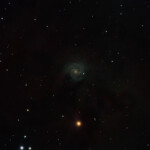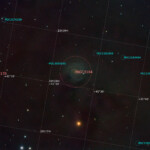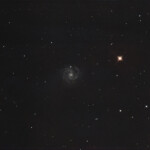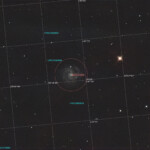NGC 3184 is a spiral galaxy approximately 40 million light-years away in the constellation Ursa Major. It is oriented face on, with a small nucleus and long sprawling arms. This type Sbc galaxy has striking blue spiral arms, with many pink star forming regions. Two of the largest of these HII regions are named NGC 3180 and NGC 3181. The bright stars that highlight the arms were created in huge density waves that circle the center.
NGC 3184 houses a high abundance of heavy elements and (SN 1999gi) that was a magnitude 14 Type II supernova detected on December 9, 1999. Other supernovae in NGC 3184 include 1921B (mag 13.5), 1921C (mag 11) and 1937F (mag 13.5).

NGC 3184
NGC 3184 is a spiral galaxy approximately 40 million light-years away in the constellation Ursa Major. It has two HII regions named NGC 3180and NGC 3181.
NGC 3184 houses a high abundance of heavy elements and (SN 1999gi) that was a magnitude 14 Type II supernova detected on December 9, 1999. Other supernovae in NGC 3184 include 1921B (mag 13.5), 1921C (mag 11) and 1937F (mag 13.5).
Photographed with MN190 reflector telescope and Atik 360EX CCD camera in Stuvsta, March 2021. Exposure was 20 min RGB each and 11 min Lum.

NGC 3184
NGC 3184 is a spiral galaxy approximately 40 million light-years away in the constellation Ursa Major. It has two HII regions named NGC 3180and NGC 3181.
NGC 3184 houses a high abundance of heavy elements and (SN 1999gi) that was a magnitude 14 Type II supernova detected on December 9, 1999. Other supernovae in NGC 3184 include 1921B (mag 13.5), 1921C (mag 11) and 1937F (mag 13.5).
Photographed with MN190 reflector telescope and Atik 360EX CCD camera in Stuvsta, March 2021. Exposure was 20 min RGB each and 11 min Lum.

NGC 3184
Pgotographed with the RC8″ reflector telescope and the ASI 2600MC color CMOS camera in Stuvsta, February 28th and March 7th 2025. Exposure was 30*3 min with IDAS LPS D2 light pollution filter.

NGC 3184
Pgotographed with the RC8″ reflector telescope and the ASI 2600MC color CMOS camera in Stuvsta, February 28th and March 7th 2025. Exposure was 30*3 min with IDAS LPS D2 light pollution filter.
The galaxy PGC 2176964, bottom left, is 1.5 billion light years away and receeding with about 10% of the speed of light.